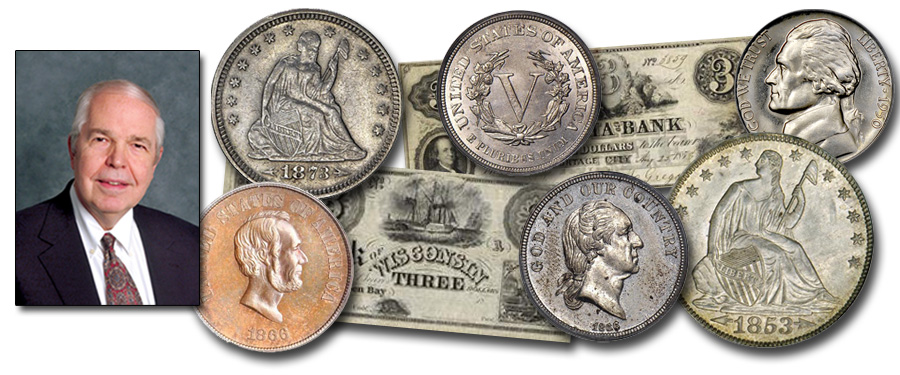
• Jefferson nickels should actually be called Jefferson coppers, as they contain much more copper (75%) than nickel (25%).
• Did the colony of Maryland have its own mint circa 1660? There are some authorizations for and mentions of such, but so far as is known, all Maryland coins were struck in England.
• Among 19th-century U.S. pattern coins, nearly all bore female heads or figures representing “Liberty,” but no specific persons, stars, shields, or other inanimate objects. Only two real persons from American history were depicted: George Washington and Abraham Lincoln, the latter only on a few rare five-cent patterns. Some have claimed that Martha Washington is shown on the 1792 half disme, but there is no factual basis for this. Now, U.S. circulating coins show real people including on the Lincoln cent, Jefferson nickel, Roosevelt dime, Washington quarter, Kennedy half dollar, and the various presidential and first spouse issues.
• Although 4,000 circulation strike 1827 quarters were reported as being minted, none except special Proof strikings are positively known today, although one in our Eliasberg Collection was circulated but may have been a spent Proof.
• All-purpose arrows: In 1853, arrows were added to the design of certain silver coins to signify a decrease in weight. However in 1873, the arrows were added to denote an increase. And, certain 1787 Connecticut coppers have arrows at the date, but for no apparent purpose other than decoration.
• The 1936 Delaware Tercentenary commemorative half dollar was actually struck in 1937 and also bears the date 1938.
• The Mint has never immediately recalled a coin because of a mistake in design, but there have been some instances in which the public thought coins would be recalled. One of these is the 1883 Liberty Head nickel without CENTS. The Mint did not include the word CENTS on the coin and rectified the situation shortly thereafter by issuing new coins with the word. However, there was no recall of the nickels and examples without the word CENTS circulated for years afterward. Another example was the 1938 Jefferson nickel. It was rumored that the flagpole had been omitted from the top of Monticello and that the coins would be recalled — a rumor that was short lived.
• During the early 19th century $3 bills were not at all unusual and were, in fact, quite common in circulation. In the early 1860s the federal government contemplated issuing $3 “greenbacks,” and made a design provision for this, but $3 bills were never produced.





